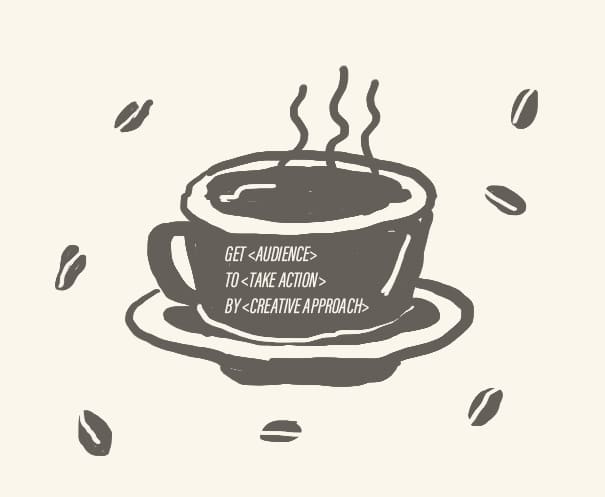November 12, 2019
The one-sentence formula for better strategy.

Would you go to a movie that’s about a <protagonist> who must <face obstacles> or else <stakes>? No, you wouldn’t. It’s all about the specifics, like:
A <maverick cop> must <keep a runaway bus from going over 40 miles an hour> or else <it explodes> (Speed).
Or:
A <grief-stricken man forced to care for his nephew> must <resolve his demons while revisiting his hometown> from a <community of body snatchers> or else <live a life forever haunted> (Manchester By The Sea).
So given the importance of specifics, why do most strategies read like this: Get <demographic> to <consider Brand X> by <talking about Brand X>?
In this post, we’ll walk through a simple approach to strategycraft and end with a defensible strategy statement:
Get <audience> to <take action> by <creative approach>.
Here’s a hypothetical brief:
Brand X is a subscription coffee service that provides savings on gourmet coffee, with curated selections delivered directly to consumers. They want creative that lowers CAC, drives performance, and lifts name recognition and organic search. They target the coveted category of Millennials, 27-35 HHI 80k +.
WHO ARE WE REALLY TARGETING?
Let’s be specific. Coffee lovers? Coffee lovers who crave variety but live in limited markets? People who are on the fence about coffee who can be made to love coffee? The more targeted your audience, the more effective your ad, and that step begins in strategy. Some buckets are bigger than others, and that’s where we use research to game out which is best for Brand X.
READ THE STORY OF THE DATA
What are the customers saying? What are your competitors doing? What trends affect coffee consumption in general? What’s distinct about your company? Look for areas where specifics about the brand overlap with broader trends in the category and with human behavior in general. Let’s say a study reveals that people who were given better coffee for six months experienced a 6% boost in productivity at work. Save and collect these observations. Note I say observations, not insights. They’re not insights yet… that’s the next step and the most crucial part of the strategy.
FORM INSIGHTS
People hunger for meaning, and all the data in the world needs a human to give it narrative meaning. Something fully verified is a fact. Facts are not stories, they are the ingredients of story. We use facts to bridge the gap between the known world and the unknown, and a good insight feels like it’s settling something that was left unresolved.
So let’s say that we take the 6% study mentioned earlier and tell a story: Good coffee fuels a 6% increase in productivity… because the morning ritual tells the story of the day to come. There, that’s a defensible insight. And we can do something with that.
WRAPPING IT ALL UP
And so, all this work, all these words, boil down into a simple, specific statement. Examples:
- Get <productivity-focused, high achievers> to <recognize Brand X as a key part of a productive life> by <illustrating how mornings shape the day>.
- Get <people who’ve never tried a subscription service> to make <Brand X their first one ever>, by <illustrating the ways changes to morning habits change everything>.
- Get< trendsetters> to <see Brand X as the go-to name in coffee> by <showcasing the variety of offerings across a series of mornings>.
Your strategy is the first step towards effective creative. It’s where you’re forced to narrow your vision, and shift the target from “everyone” and the ask from “make more money” to delving into the specifics of how narrative will be used to make that happen. The next time you’re wagering hundreds of thousands on your next campaign, protect your investment by spending extra hours narrowing down the strategy with your stakeholders. As the saying goes, if you have an hour to chop down a tree, most of the time should be used sharpening the axe.
